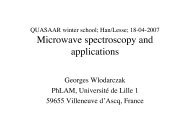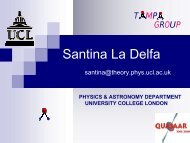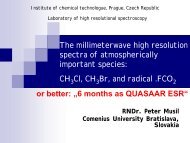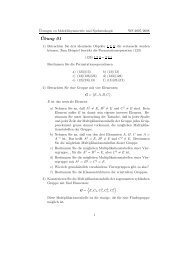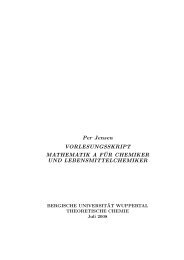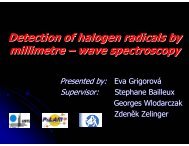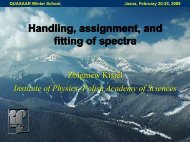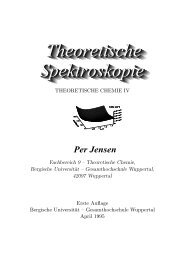Abstract book - Prof. Per Jensen, Ph.D. - Bergische Universität ...
Abstract book - Prof. Per Jensen, Ph.D. - Bergische Universität ...
Abstract book - Prof. Per Jensen, Ph.D. - Bergische Universität ...
- No tags were found...
Create successful ePaper yourself
Turn your PDF publications into a flip-book with our unique Google optimized e-Paper software.
50 Poster session, D3Ab-initio normal-mode vibrational displacement vectors for the threeC-H stretching vibrations along the internal rotation path in methanolJon T. Hougen 1 , Li-Hong Xu 2 , Ronald M. Lees 21 Sensor Science Division, National Institute of Standards and Technology,Gaithersburg, MD 20899-8441, USA, jon.hougen@nist.gov; 2 Centre for Laser, Atomic,and Molecular Sciences (CLAMS), Department of <strong>Ph</strong>ysics, University of NewBrunswick, Saint John, NB, Canada, E2L 4L5, lxu@unb.ca, lees@unb.caHougen J.T.Xu L.-H.Lees R.M.Modern quantum chemistry packages can be used to determine the small-amplitudevibrational frequencies i() and Cartesian displacement vectors d i() along a largeamplitudeinternal rotation (torsional) coordinate . We focus here on the d i() for thethree CH stretching motions ( 2, 3, and 9) along the steepest-descent internal rotationpath in methanol (CH 3OH), which are interesting because the symmetry environmentof each C-H bond changes during the internal rotation, i.e., each of the methyl bondstakes turns passing through the plane of symmetry of the COH frame of the molecule.Graphical displays show that the d i() for frame atoms have a three-fold periodicityalong the torsional coordinate, i.e., they are given by Fourier series in cos3n or sin3nwith integer n. On the other hand, the d i() for each methyl hydrogen have only 2periodicity along the torsional coordinate, with Fourier series in cosn or sinn. Termsin the simplified torsion-rotation Hamiltonian resemble terms in the simplifiedHamiltonians for the Jahn-Teller and Renner-Teller vibronic problems. The torsionvibrationcoupling terms for the present problem take the formk 1(e +i Q + 2 + e -i Q - 2 ) + k 2(e -2i Q + 2 + e +2i Q - 2 ),where Q = Q x iQ y represent components of a “doubly-degenerate vibration” formedby combining 2 and 9. Closed form equations for the d i() can be obtained for thelimiting cases with either k 1 = 0 or k 2 = 0. If only the first (or second) coupling term ispresent, these d i() transform into their negatives (or themselves) when the moleculeundergoes one full internal rotation. For the CH stretches in methanol the two termsseem to be of almost equal importance. We also consider calculations of the A/Etorsional splittings in the excited v = 1 fundamental states of the three CH stretches frominformation given by a quantum chemistry calculation. The splitting in 3 has the samesign as the ground state, but for 2 and 9 it has a sign opposite to the ground state.Several papers in the literature give theoretical explanations for this sign behavior usingperturbation theory based on a diabatic treatment, where the interaction terms arepresent in the potential energy expression (e.g., the terms given above). Quantumchemistry output corresponds, however, to an adiabatic situation where all vibrationtorsioninteraction terms in the potential energy surface have been “diagonalized out,”so that the torsion-vibration interactions are transferred to the kinetic energy operator,where they appear as a “new Coriolis interaction term.” The coefficient in front ofthis new Coriolis operator depends on derivatives with respect to of the d i() vectors.Quantum-mechanical situations where all perturbations occur in the kinetic energyoperator are relatively unfamiliar to high-resolution molecular spectroscopists, so thenew features in such a calculation will be described briefly.




